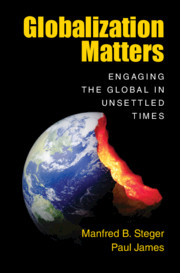Book contents
- Globalization Matters
- Globalization Matters
- Copyright page
- Contents
- Figures
- Acknowledgements
- 1 Introduction
- 2 Mapping a New Genealogy of ‘Globalization’
- 3 Rethinking the Dominant Framework of Globalization Theory
- 4 Considering the Subjective Dimensions of Globalization
- 5 Outlining an Engaged Theory of Globalization
- 6 Excavating the Long History of Globalization
- 7 Examining the Promise of Global Studies
- 8 Making Sense of the Populist Challenge to Globalization
- 9 Confronting the Global Urban Imaginary
- 10 Living in the Unsettled World of the Anthropocene
- 11 Concluding Reflections
- Appendices
- Bibliography
- Index
3 - Rethinking the Dominant Framework of Globalization Theory
Published online by Cambridge University Press: 01 August 2019
- Globalization Matters
- Globalization Matters
- Copyright page
- Contents
- Figures
- Acknowledgements
- 1 Introduction
- 2 Mapping a New Genealogy of ‘Globalization’
- 3 Rethinking the Dominant Framework of Globalization Theory
- 4 Considering the Subjective Dimensions of Globalization
- 5 Outlining an Engaged Theory of Globalization
- 6 Excavating the Long History of Globalization
- 7 Examining the Promise of Global Studies
- 8 Making Sense of the Populist Challenge to Globalization
- 9 Confronting the Global Urban Imaginary
- 10 Living in the Unsettled World of the Anthropocene
- 11 Concluding Reflections
- Appendices
- Bibliography
- Index
Summary
This chapter shifts to an assessment of the main currents of globalization theory. It traces the twists and turns taken by different approaches, placing the rationale for Globalization Matters in the context of the strengths and limits of current theoretical orientations. A central paradox emerges. Recognition of the importance of understanding globalization as a generalizing category came to the fore at the very same time that an aversion to generalizing theory emerged. Our exposition is framed by a critical overview of the conventional three-wave model—widely distinguished as the hyperglobalizers, the sceptics, and the transformationalists. This model does not work for many reasons. To be sure, waves and corresponding schools of thought are accessible metaphors that possess descriptive utility for introductory surveys. But they have less value for the development of global theory beyond entrenched and rather petrified positions. Our synchronic framework conveys a much messier picture of simultaneous and frequent interactions among four analytically distinct modes of theorizing the global: neoclassical theorists, domain theorists, complexity theorists, and generalizing theorists.
- Type
- Chapter
- Information
- Globalization MattersEngaging the Global in Unsettled Times, pp. 50 - 77Publisher: Cambridge University PressPrint publication year: 2019

